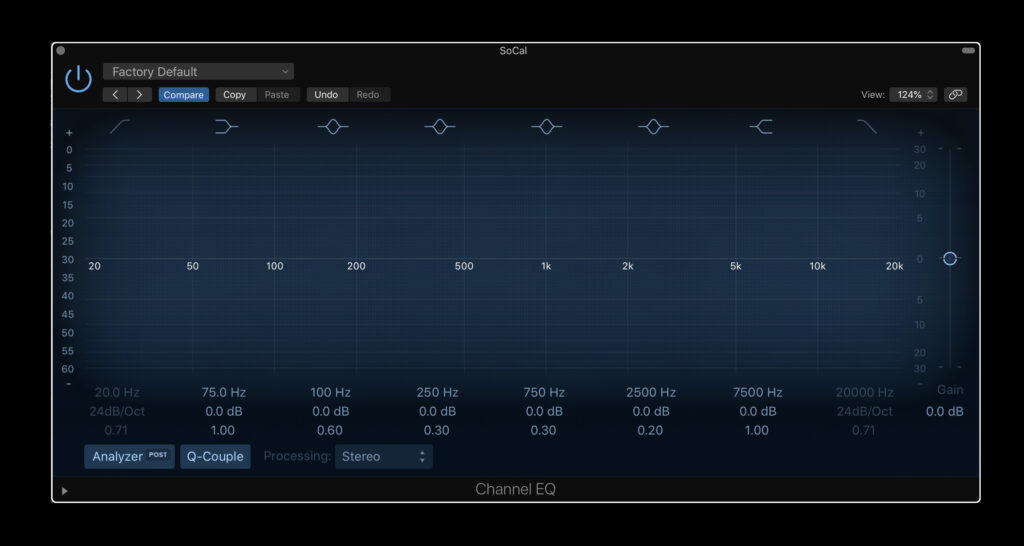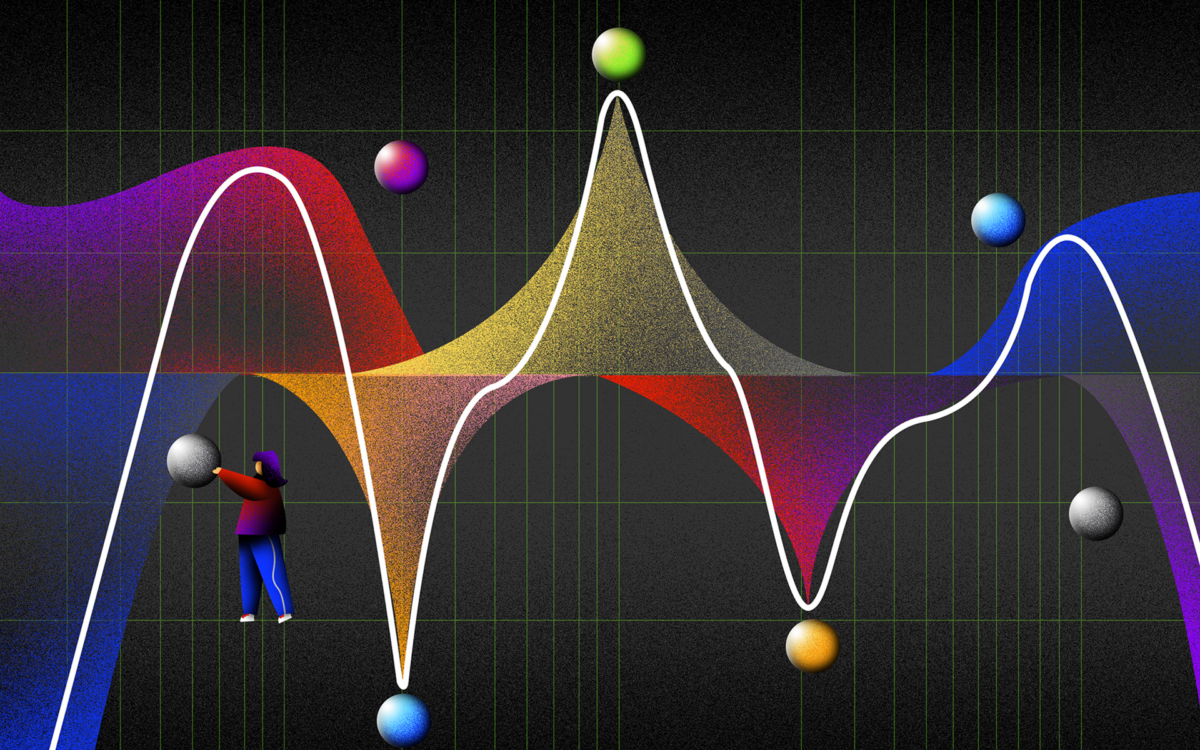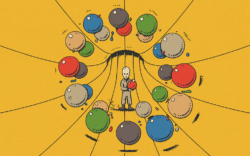Illustration: Jordan Moss
Even if you’ve never used it in the music creation process, there’s a good chance you’ve played with some form of EQ before.
Whether it’s the bass and treble knobs on a stereo system or the audio balance settings on a streaming service, EQ is quite literally all around us. In this article, we’ll explore what EQ is, some common types, and how to use them in your music.
See our table of contents below to quickly navigate to a specific section.
What you’ll learn:
- What is EQ?
- EQ ranges: Low, mid, and high
- Some key terminology
- How to use EQ in your music
- Common EQ types
- EQ plugins to try out
Feeling ready? Let’s dive in!
What is EQ?
EQ (a shorthand for equalization) is an incredibly useful tool in music production that allows us to control the balance of different frequencies in a sound. It can be applied boldly for sound design, or subtly to surgically correct mistakes or make sounds fit with each other in a mix.
To understand how EQ works, it’s important to first understand the role that frequencies play in shaping sounds.
What are frequencies in audio?
When we’re creating our own music, we often think about things like rhythms, melodies, and chords. However, when we use EQ, we’re shifting gears and thinking more about the balance of frequencies, which are the actual vibrations that we hear.
Frequencies are measured by their cycles per second (essentially their speed), and are expressed via the unit hertz (Hz). While it can vary from person to person, the typical range of hearing for humans is 20 Hz – 20 kHz (20,000 Hz).
When we hear a complex sound like the strumming of an electric guitar, there’s not just one or two of these frequencies at play—rather, there’s an intricate mix of countless frequencies within this wide range that make up the timbre, or sonic character, of the sound.
As stated in the beginning, what EQ allows us to do is adjust the balance of these frequencies to get the desired timbre we’re looking for. In other words, when we use EQ, we’re not making things lower or higher in pitch. Rather, we’re typically using it to make things sound brighter, bassier, clearer, etc.
What EQ looks like
Most DAWs come with a multi-band EQ plugin that looks something like this:

The Channel EQ in Logic Pro X
The x-axis represents frequency—we see that this EQ (and most EQs) covers the full range of hearing we just mentioned, 20 Hz – 20 kHz. The y-axis is decibels, which correlates to loudness. Taking these two axes into consideration, what this EQ essentially provides us is volume faders across the full frequency spectrum; we can use it to draw in boosts and cuts where we want to increase or decrease the level of certain frequency ranges.
What EQ sounds like
A listen is worth a thousand words—hear how adjustments in EQ impact the sound of some drums in real time:
Notice how the kick becomes more prominent when we boost the lower frequencies, how the attack of the hi-hats becomes sharper when we boost the high frequencies, and how the timbre of the snare changes as we cut and boost the frequencies in the middle.
EQ ranges: Low, mid, and high
These specific ranges aren’t set in stone, but when music producers make observations like “the low end sounds muddy” or “the high mids are too bright,” these frequency ranges are generally what are being referred to:
- Low: 20 – 250 Hz
- ‘Muddiness’ can occur when there’s excessive build up around 200 Hz
- Low Mid: 250 Hz – 1 kHz
- To reduce ‘boxiness,’ consider attenuating around 400 – 500 Hz
- Mid: 1 kHz – 4 kHz
- ‘Tinny’ or ‘nasally’ characteristics can be targeted around 1 – 2 kHz
- High Mid: 5 kHz – 8 kHz
- ‘Harsh’ frequencies can often lie between 6 – 8 kHz
- High: 8 kHz – 20 kHz
- ‘Air’ and ‘brightness’ can be found around 10 kHz for instruments such as cymbals and piano
When trying to create a full-sounding mix, it’s important to make sure all of these ranges have some amount of representation in your track.
Some key terminology
In addition to the ranges above, you’ll likely run into some other common terms as you use EQ in your music. Here’s a list of a few concise definitions that can be worth familiarizing yourself with:
- Bandwidth: The range of frequencies that are being affected.
- Q: A variable that determines how far the boost or cut range expands from the center frequency—this helps define the bandwidth (a higher Q equals a narrower bandwidth).
- Shelving EQ: An EQ that attenuates frequencies above or below a designated cutoff frequency; high pass and low pass filters are types of shelving EQ.
- High pass: An EQ adjustment that attenuates frequencies below a designated frequency, leaving what’s above its cutoff unaffected.
- Low pass: An EQ adjustment that attenuates frequencies above a designated frequency, leaving what’s below its cutoff unaffected.
- Low cut: Synonymous to a high pass.
- High cut: Synonymous to a low pass.
- Band-pass: An EQ adjustment that leaves a middle band unaffected, attenuating high and low frequencies.
- Band-stop: An EQ adjustment that attenuates a specific band, while leaving other areas unaffected.
- Notch filter: A band-stop filter with a very high Q factor.
How to use EQ in your music
There are no hard rules for how to use EQ, and the best way to get good at it is to experiment with it firsthand. That said, we’ve highlighted some ideas below for how you might most commonly use EQ in your music.
1. To correct something
EQ is often used to bring out the best of a performance and to attenuate the less desirable elements. If your vocal performance lacks definition, you can give the higher frequencies a boost to make it feel more clear and crisp. On the other hand, if it sounds too harsh or hissy, you can reduce these same frequencies for a more well-rounded sound.
2. To create space for something else
In general, instruments will sound clearer in your mix if they’re not competing for attention with a million other elements that mainly reside in the same frequency range. If you have a bass guitar and a kick drum, for example, you can use EQ to boost and cut different frequency ranges within the low end (usually by just a few decibels at most—no need to overdo it) so that each sound has its own sonic range where it can shine.
3. To achieve balance
For the most part, mixes sound the best when they have some content across our full range of hearing. We often use EQ with this macro perspective in mind, making sure our overall track sounds full and engaging.
4. To achieve a creative effect
EQ can also be used in more extreme ways for creative purposes; for example, cutting out all the frequencies below 2 kHz can make your audio sound like it’s playing out of a cheap radio, while if you cut everything above it, it can feel like you’re listening to something underwater. We can even use automation to change parameters over time to simulate something being gradually brightened or drowned out.
Automating a high-cut filter’s cutoff frequency creates the feeling of a sound being submerged or removed from under water.
Common EQ types
While we looked at a multi-band parametric EQ above, there are also several other types of EQ, particularly when it comes to hardware or plugins that emulate hardware interfaces. Below are a few that you may want to be aware of.
Graphic EQ
A graphic EQ has a fixed number of bands for fixed frequencies. A 30-band graphic EQ, for example, has 30 faders that can boost or attenuate the gain—the frequencies across the spectrum are distributed so that octaves are positioned equidistantly. Each of these bands can be adjusted within a range of +/- 6 dB or more, depending on the particular model.
A graphic EQ has less controls and is therefore accessible and easy to work with, in exchange for the ability to fine-tune. For this reason, graphic EQs are more commonly seen in live sound setups rather than in a studio.
Parametric EQ
On the other hand, a parametric EQ can also control the center frequency and bandwidth. A graphic EQ may have a fixed center frequency of 100 Hz, while a parametric EQ can adjust its center frequency to 95 Hz, 100 Hz, 105 Hz, etc.
Semi-parametric EQ
A semi-parametric EQ lies somewhere in between the two—most often, it lacks the Q control. A multi-band EQ where only select bands are fully parametric is also commonly referred to as a semi-parametric EQ.
EQ plugins to try out
So now that we have an idea of what EQ is and its common applications, how do we actually get started with using it?
Most of us who are making music in a DAW will reach for a plugin (as opposed to outboard gear) when getting started with EQ. All common DAWs should have a native option—like Logic Pro’s Channel EQ or Ableton Live’s EQ Eight—that offers more than enough features and functionality for your basic EQ needs.
That said, if you want to dive deeper into specific workflows or access more advanced features, there are also a wide array of third-party plugins available; for example, the EQ in iZotope’s Neutron lets you set thresholds to dynamically adjust the effect in real time, while the SITRAL-295 in Arturia’s FX Collection draws on the UI and sound of Siemens’™ classic broadcast console. Fabfilter’s Pro-Q3 is another classic EQ with a clean and precise workflow that’s adored by mixing and mastering engineers across the world.
If you’re on a budget but still want to venture beyond what’s offered in your DAW, you can also try free third-party plugins like Sonimus’ SonEQ, which we featured in our list of the ten best free mixing plugins.
Conclusion
Hopefully this guide gave you a strong foundation for getting started with using EQ—it’s one of the most central and versatile effects in music production, and learning how to use it effectively will be one of the best long-term investments you can make as a creator.
Do you have any questions on EQ? What other topics would you like to see us cover on our blog next? Start a conversation with us via the Splice Discord.
Explore royalty-free one-shots, loops, FX, MIDI, and presets from leading artists, producers, and sound designers:
November 9, 2023

.svg)
.svg)




